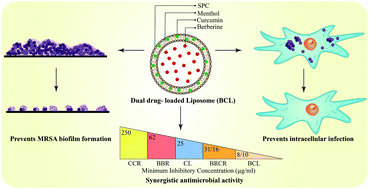Combinatorial liposomes of berberine and curcumin inhibit biofilm formation and intracellular methicillin resistant Staphylococcus aureus infections and associated inflammation
Abstract
The increase in drug-resistant strains of Staphylococcus aureus, especially methicillin-resistant S. aureus (MRSA), has led to an increased rate of infection-related mortality. The emergence of drug resistance has rendered many antibiotics ineffective. The poor penetration and retention of antibiotics in mammalian cells lead to recurrent latent infections. Thus, there is an increasing need for biodegradable, non-toxic anti-infectives that are effective in treating MRSA infections. Phytochemicals such as berberine (BBR) and curcumin (CCR) have long been explored for their antibacterial activities, but their efficacy is often limited due to low bioavailability, water solubility, and poor cell penetration. When used in combination these antimicrobials did not show any synergistic effect against MRSA. Here, both of them were co-encapsulated in liposomes (BCL) and evaluated for biocompatibility, synergistic antimicrobial activity, intracellular infections, associated inflammation, and on biofilms formed by MRSA. Co-encapsulation of BBR and CCR in liposomes decreased their MICs by 87% and 96%, respectively, as compared to their free forms with a FICI of 0.13, indicating synergy between them. BCL inhibited the growth of MRSA and prevented biofilm formation better than free drugs. Co-culture studies showed that intracellular infection was reduced to 77% post BCL treatment. It also reduced the production of pro-inflammatory cytokines by macrophages following infection. The liposomes were found to be five times more efficient than clindamycin and can be used as a potential antimicrobial carrier against intracellular infections.

- This article is part of the themed collection: Showcasing recent research in materials chemistry from IIT Bombay, IIT Indore and IISc


 Please wait while we load your content...
Please wait while we load your content...